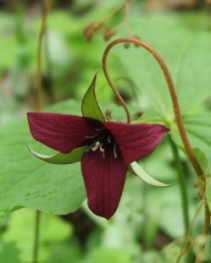
Big bursts of yellow forsythia call out to us in late April, like billboards for spring, easy to see as we fly by in cars, trains, or on bicycles.
It's a welcome sight, but the picture is missing something. Forsythia is not native to our area—and, therefore, not of life-nurturing importance to some early-emerging insects such as bumblebee queens, some butterflies, flies, wasps, and moths."
Some of these choosy creatures rely on early-blossoming native flowers. These early flowers are called spring ephemerals because, usually by summer, their flowers and leaves will die and disappear entirely.
Pictured here is wake-robin or red trillium, Trillium erectum. They are important sources of sustenance to native insects, and the insects provide benefits to the plants by pollinating flowers. Some ants, like the pollinators, also derive important nutrition from the seeds. Ants spread the seeds of violets, for instance.
If you want to see these worthy native flowers, slow down and focus on the woodlands, streamsides, and rocky ledges. A good book can help with identification, such as Wildflowers of New England by Ted Elliman and the New England Wild Flower Society (Timber Press). As you start to learn about ephemerals, you'll find that they emerge and blossom in spring because they need the dappled sunshine of open woodlands. They specialize in the weeks before trees get their leaves in mid to late May. Most are less than 12 inches tall. Most blossom for less than two weeks, some for just a few days.
By all means, enjoy the bright blast of forsythia. But if you want to know what really puts the buzz in an April day, it's important to retrain your focus to a much smaller scale.
To learn more, see https://www.zip06.com/special/20190411/slow-down-to-see-springs-ephemeral-flowers-beautiful-important-and-short-lived.
Also see: April's wildflowers, fleeting bright spots
Also see: Flowers for the Queen (Bee)
